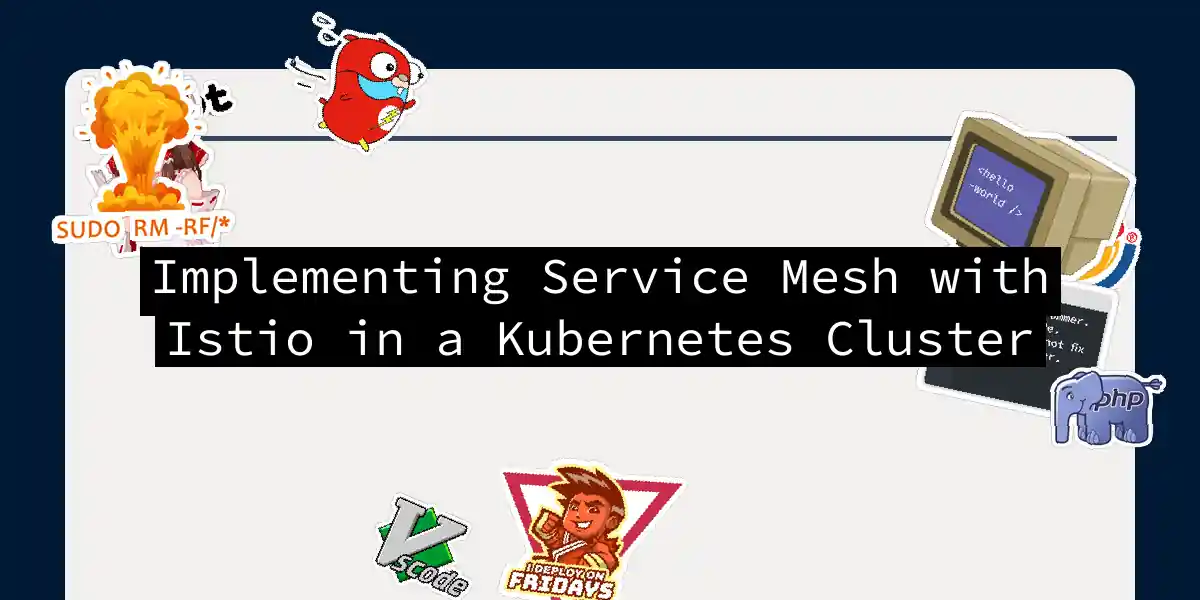Implementing a Service Mesh with Istio in a Kubernetes cluster is like adding a superpower to your microservices architecture. It’s akin to giving your services a cape and a utility belt, making them more resilient, secure, and manageable. In this article, we’ll dive into the nitty-gritty of setting up Istio in your Kubernetes cluster, complete with code examples and diagrams to guide you through the process.
Why Service Mesh?
Before we jump into the implementation, let’s quickly address why you might need a Service Mesh. In a microservices architecture, services communicate with each other, and this communication can become complex. A Service Mesh like Istio helps manage this complexity by providing features such as traffic management, security, observability, and more.
Prerequisites
To get started, you’ll need a few things:
- A Kubernetes cluster (you can use Minikube, Kind, or any cloud provider)
kubectlinstalled and configured to your clusteristioctl(the Istio command-line tool)- Docker (if you’re building your own images)
Installing Istio
Installing Istio involves a few steps, but don’t worry, it’s not as complicated as assembling IKEA furniture.
Step 1: Download Istio
First, download the Istio release that matches your Kubernetes version. You can find the latest releases on the Istio GitHub page.
curl -L https://istio.io/downloadIstio | sh -
cd istio-*
Step 2: Install Istio
Istio provides several installation profiles to suit different needs. For this example, we’ll use the default profile.
istioctl install --set profile=default
This command will install the core components of Istio, including the control plane and the sidecar proxies.
Step 3: Verify Installation
To ensure everything is up and running, you can check the status of the Istio components.
kubectl get pods -n istio-system
You should see pods like istiod, istio-ingressgateway, and istio-egressgateway.
Enabling Sidecar Injection
For Istio to manage your services, you need to enable sidecar injection in your namespace. This will automatically inject the Istio proxy into your pods.
kubectl label namespace default istio-injection=enabled
Deploying a Sample Application
Let’s deploy a simple application to see Istio in action. We’ll use the bookinfo application provided by Istio.
kubectl apply -f samples/bookinfo/platform/kube/bookinfo.yaml
Understanding the Architecture
Here’s a high-level overview of how Istio works within your Kubernetes cluster:
Traffic Management
One of the powerful features of Istio is traffic management. You can control how traffic flows between services using VirtualServices and DestinationRules.
VirtualService Example
Let’s create a VirtualService to route traffic to different versions of the reviews service.
apiVersion: networking.istio.io/v1beta1
kind: VirtualService
metadata:
name: reviews
spec:
hosts:
- reviews
http:
- match:
- headers:
end-user:
exact: jason
route:
- destination:
host: reviews
subset: v2
- route:
- destination:
host: reviews
subset: v1
DestinationRule Example
To define subsets for the reviews service, you need a DestinationRule.
apiVersion: networking.istio.io/v1beta1
kind: DestinationRule
metadata:
name: reviews
spec:
host: reviews
subsets:
- name: v1
labels:
version: v1
- name: v2
labels:
version: v2
Security
Istio provides robust security features, including mutual TLS and service identity.
Enable Mutual TLS
To enable mutual TLS for the reviews service, you can use a DestinationRule.
apiVersion: networking.istio.io/v1beta1
kind: DestinationRule
metadata:
name: reviews
spec:
host: reviews
trafficPolicy:
tls:
mode: ISTIO_MUTUAL
Observability
Istio integrates well with various observability tools like Prometheus, Grafana, and Kiali.
Installing Kiali
Kiali is a visualization tool for Istio that helps you understand the traffic flow and service dependencies.
kubectl apply -f samples/addons/kiali.yaml
You can access Kiali via the Istio ingress gateway.
kubectl port-forward -n istio-system $(kubectl get pod -n istio-system -l app=kiali -o jsonpath='{.items.metadata.name}') 20001:20001 &
Then, open your browser and navigate to http://localhost:20001.
Conclusion
Implementing a Service Mesh with Istio in your Kubernetes cluster is a powerful way to manage your microservices architecture. With features like traffic management, security, and observability, Istio makes your services more resilient and easier to manage.
Remember, Istio is not a magic wand that solves all your problems instantly; it’s more like a Swiss Army knife that helps you tackle various challenges in your microservices journey. So, go ahead, give Istio a try, and see how it can supercharge your services
